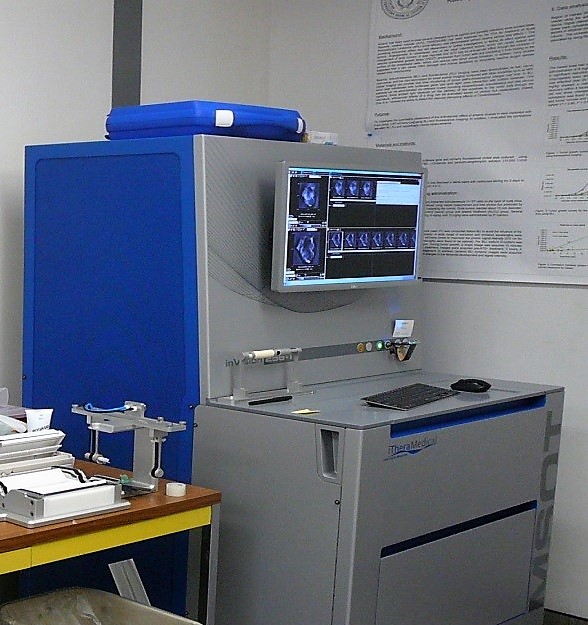iThera MSOT

The iThera MSOT 256TF provides versatile specificity of optical contrast with high-resolution real-time ultrasound detection, allowing for the study of physiological processes at a molecular and cellular level. It provides a unique capacity to separate signals of interest, including tissue contrast from extrinsically administered agents (fluorescent dyes, nanoparticles, etc), and oxy/deoxy hemoglobin.
The instrument is equipped for high sensitivity from 680 to 980 nm in 1 nm increments with 100 ms temporal resolution. Images are captured through a tomographic array with a coverage angle of 270 degrees, enabling more accurate imaging of complex shapes than typical linear detection. This array sits perpendicular to the axis of the animal, giving a cross section for each image. A ‘stack’ of cross sectional images can be rendered into a 3D image offline. Each cross section is typically 20x20 mm, but can increase to 40x40 mm. In plane resolution approaches 120 μm. Spectra of unknown substances can be unmixed from intrinsic signals (typically Hb, HbO2 and melanin) and stored for future use.
Investigators may request full service imaging or be trained to undertake investigations
Instrument purchase supported by NIH 1 S10 OD018094-01A1
Recent publications
Oxygen-enhanced optoacoustic tomography reveals the effectiveness of targeting heme and oxidative phosphorylation at normalizing tumor vascular oxygenation, P. Ghosh, Y. Guo, A. Ashrafi, J. Chen, S. Dey, S. Zhong, J. Liu, J. Campbell, P. Chaitanya Konduri, J. Gerberich, M. Garrossian, R. P. Mason, L. Zhang, and L. Liu, Cancer Res., accepted 2020
Evaluating Online Filtering Algorithms to Enhance Dynamic Multispectral Optoacoustic Tomography, D. O’Kelly, Y. Guo, and R. P. Mason, Photoacoustics, 2020
Noninvasive Anatomical and Functional Imaging of Orthotopic Glioblastoma Development and Therapy using Multispectral Optoacoustic Tomography, G. Balasundaram, L. Ding, L. Xiuting, A. Attia, X. Luis, D. Ben, C. Jun, H. Ho, P. Chandrasekharan, H. C. Tay, H. Q. Lim, C. Bing Ong, R. P. Mason, D. Razansky, M. Olivo, Trans. Oncol., 11, 1251-1258 (2018).
“Noninvasive Anatomical and Functional Imaging of Orthotopic Glioblastoma Development and Therapy using Multispectral Optoacoustic Tomography”, G. Balasundaram, L. Ding, L. Xiuting, A. Attia, X. Luis, D. Ben, C. Jun, H. Ho, P. Chandrasekharan, H. C. Tay, H. Q. Lim, C. Bing Ong, R. P. Mason, D. Razansky, M. Olivo, Trans. Oncol., 11, 1251-1258 (2018).
Commentary on Photoacoustic Tomography R. P. Mason, J Nucl Med. First published September 17, 2015.
“Oxygen breathing challenge- the simplest theranostics” R. P. Mason, Theranostics, 2017; 7(16): 3873-3875.
“In Vivo Chemiluminescent Imaging Agents for Nitroreductase and Tissue Oxygenation” J. Cao, J. Campbell, L. Liu, R. P. Mason, and A. R. Lippert, Analyt. Chem. 88 (9): 4995-5002 (2016).
“The vascular disrupting agent combretastatin A-4 phosphate causes prolonged elevation of proteins involved in heme flux and function in resistant tumor cells”, S. Dey, S. Kumari, S. P. Kalainayakan, J. Campbell III, P. Ghosh, H. Zhou, K. E. FitzGerald, M. Li, R. P. Mason, L. Zhang, L. Liu, Oncotarget, 9: 4090-4101, (2018).
“Exploring a fluorescent blood pool agent in photoacoustic imaging” H. Zhou, J. Campbell, D. O'Kelly, J. Gerberich, R. P. Mason, SNMMI San Diego, June 2016 (J. Nucl. Med., 57 (supplement 2), 1214)
“Monitoring Tumor Response to Vascular Disrupting Agent Using Photoacoustic Tomography and Multiparametric MRI” H. Zhou, J. Campbell, Z. Zhang, D. Saha, M. L. Trawick, K. G. Pinney, R. P. Mason, SNMMI San Diego, June 2016 (J. Nucl. Med., 57(supplement 2), 1408-1408)

